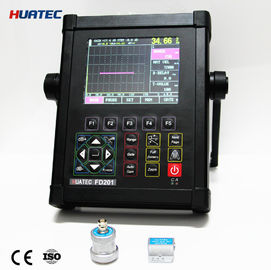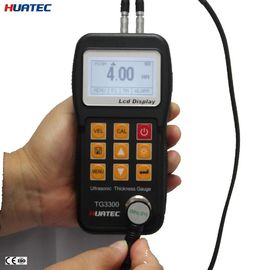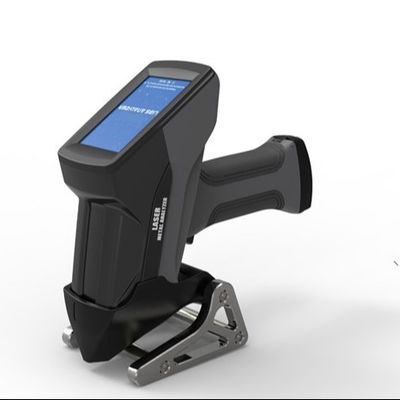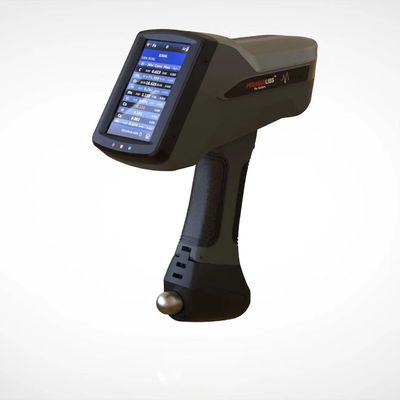IP54 Hand-Held LIBS Laser Alloy Material Identification And Carbon PMI Analyzer
Performance Features
1) Elements can be analyzed and detected (commonly used):Beryllium Be, Magnesium Mg, Aluminum Al, Silicon Si, Titanium Ti, Vanadium V, Chromium Cr, Manganese Mn, Iron Fe, Cobalt Co,Nickel Ni, Copper Cu, Zinc Zn, Niobium Nb, Molybdenum Mo, Tin Sn, Tungsten W, lead Pb, Bi Bi
2) Can quickly detect and identify aluminum alloy, copper alloy, nickel alloy, stainless steel, low and medium alloy steel and other alloy grades and main element content, the instrument is pre-installed UNS grade library, users can also customize the grade library.
Technology performance
1) The instrument design is robust and durable, and the aluminum alloy body has IP54 dustproof and waterproof.
2) Fast detection: one second can display the material grade, you can also choose the high-precision mode of quantitative detection.
3) Safe and reliable, no radiation hazards. There is no government safety control requirement for either sales or use.
4) Excellent ergonomic design, the weight of the whole machine includes 1.25 kg battery, the size is small, strong and durable, and the standard two batteries are enough to cope with the workload of one day.
5) Ambient temperature adaptability: recommended working ambient temperature 5℃-40℃.
6) Based on the operating system developed by Linux, the interface is clean and simple, and the touch screen operation is convenient.
8) The excitation source uses class 3B low-power high-performance safety pulse laser, 1064nm all-solid, passive Q-switched laser, pulse output up to 100 microfocal.
9) An optical system based on a micro-shining grating, using a high-resolution micro-CCD /CMOS detector
10) Adopt the most advanced empirical coefficient algorithm, combined with the unique patented vibration light path detection technology: penetrating laser ablation detection technology, which can reciprocate the sample axial ablation, can ablate the pollutants and oxide film on the sample surface, analyze the deeper sample signal, and obtain the most accurate spectral information
Application areas of handheld LIBS devices
1, Alloy material identification (PMI) - incoming inspection, inventory material management, installation material reinspection
In petrochemical construction, pressure vessels, metallurgy, petroleum, electric power, aerospace and other industries, alloy material identification is a major part of the safety production management system. As we all know, mixing or using substandard materials can cause serious safety accidents (fire, explosion, etc.). Many companies and industry organizations have developed strict raw material evaluation procedures to ensure that the alloy materials used in production and installation are consistent with the requirements of engineering design.
2, Gold scrap recycling
In recent years, the development of metal waste recycling industry is extremely rapid, in the face of complex and diverse alloy types and good and bad material quality, we must use cash detection methods, rapid and accurate analysis and detection on the spot to adapt to changing market conditions, so as to be in an invincible position in the fierce industry competition. The hand-held LIBS alloy analyzer can perform on-site detection and rapid sorting of large amounts of metal scrap, providing buyers and sellers with the necessary information to make quick and reliable judgments when trading raw materials.
3, Quality assurance and quality control (QA/QC)
In the metal product manufacturing industry, material quality assurance and quality control (QA/QC) is essential. Due to the use of non-conforming or unqualified metal materials, it often brings losses to production enterprises. At present, hundreds of hand-held LIBS alloy analyzers are used in this industry, from small metal manufacturers to large aerospace manufacturers, hand-held LIBS alloy analyzers are gradually designated as a powerful weapon for alloy material verification in quality systems (QA/QC).



Appendix: Application cases of hand-held LIBS devices in the aluminum alloy industry:
1. The classification of raw materials before aluminum alloy smelting - usually large aluminum alloy production and processing enterprises have melting equipment, they will be in accordance with the requirements of customers or production, the primary aluminum and recycled aluminum alloy plus other elements smelted into the required alloy. The closer the raw material composition used is to the grade of alloy to be produced, the lower the smelting cost. At this time, the use of more expensive pure copper, pure aluminum, or pure magnesium will be reduced, and the melting time and holding time can also be shortened (saving energy). This requires a tool that can quickly perform composition analysis and grade recognition in the field to help with raw material classification.
For example, the hand-held LIBS alloy analyzer purchased by HUATEC HXRF-1XLIBS is mainly used for the classification of aluminum alloy scraps before melting. HUATEC HXRF-1XLIBS supplies four aluminum alloys for Ford's F-150 Raptor pickup truck: 6022, 6111, 5182, 5754. Aluminum scraps from the Ford plant are recycled by American Aluminum and resmelted as raw materials. HUATEC HXRF-1XLIBS will try to use scraps of 6000 series aluminum alloy in the production of 6000 series aluminum alloy, and will also try to use scraps of 5000 series aluminum alloy in the production of 5000 series aluminum alloy to reduce the amount of pure magnesium and other pure elements.
2. Aluminum alloy processing enterprises of raw materials (such as aluminum ingots) into the factory rapid quality inspection/confirmation (quality inspection).
Aluminum alloy processing enterprises usually buy aluminum ingots/aluminum plates as raw materials, and can only rely on the inspection report provided by the seller or the laboratory after sample preparation through OES (spark direct reading spectrometer) for inspection, but OES testing is more inconvenient and can not detect thin plates. There have been material suppliers mistakenly 1060 (magnesium Mg:0.03, Manganese Mn≤0.05) aluminum plate as 3004 (magnesium Mg:0.8 ~ 1.3, Manganese Mn 1.0 ~ 1.5) aluminum plate sold to customers for structural use, resulting in serious quality accidents. A hand-held LIBS alloy analyzer can avoid such problems.
3. Aluminum alloy processing enterprises in the production process and finished product grade confirmation or composition analysis (quality control)
Some aluminum alloy processing enterprises may use different grades of aluminum alloy processing parts, sometimes inadvertently mixed, then you can use the hand-held LIBS alloy analyzer for rapid grade recognition to confirm. You can also use the hand-held LIBS alloy analyzer for 100% full inspection of aluminum alloy products before leaving the factory, and the detection is non-destructive. The spark direct reading spectrometer is usually not used for the direct detection of the finished product because it is lossy and requires sample preparation. If the copper alloy production enterprise requires that the entire production process cannot contain "beryllium" or other harmful elements, then you can confirm whether the raw materials, semi-finished products, and finished products at any time through the hand-held LIBS alloy analyzer.
4. Carbon measurement application (not standard,extra order function):
Carbon is one of the most common elements in nature, in mining, metal smelting, material manufacturing and other links, carbon elements will inevitably be introduced into metal materials, and has an important impact on the mechanical properties of metals and manufacturing processes, so it is of great significance to achieve accurate detection of carbon content in metals. The HUATEC handheld LIBS analyzer makes up for the shortcomings of traditional X-ray fluorescence technology for carbon analysis, such as carbon steel grade determination and element content analysis, as well as the identification of materials with carbon as a distinguishing element.

Elements to be analyzed
| Analysis mode |
Analysis elements |
| HUATEC HXRF-1XLIBS |
Be, Mg, Al, Si, Ti, V, Cr, Mn, Fe, Co, Ni, Cu, Zn, Nb, Mo, Sn, W, Pb,Bi |
Carbon can be tested as extra order function

 Your message must be between 20-3,000 characters!
Your message must be between 20-3,000 characters! Please check your E-mail!
Please check your E-mail!  Your message must be between 20-3,000 characters!
Your message must be between 20-3,000 characters! Please check your E-mail!
Please check your E-mail! 


















